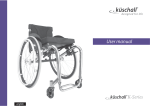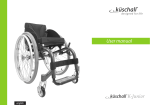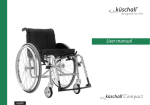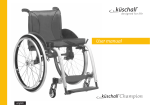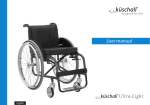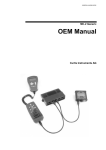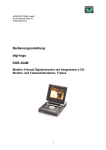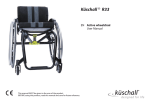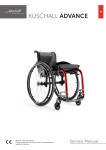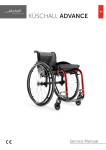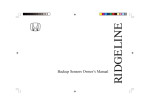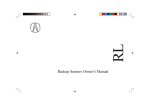Download Gebrauchsanleitung User manual Mode d'emploi
Transcript
User manual Gebrauchsanleitung Mode d‘emploi english deutsch français Table of contents 1 General ................................................................................3 1.1 1.2 1.3 1.4 1.5 Introduction .................................................................................. 3 Warning and instruction signs...............................................3 Description of the wheelchair................................................3 Use as per specifications ..........................................................3 Before using the wheelchair ...................................................3 2 Using the wheelchair..........................................................4 2.1 Sitting down / getting up ........................................................4 2.2 Driving and steering the wheelchair................................... 4 2.3 Driving over stairs and steps .................................................. 5 2.4 Driving on ramps and slopes..................................................7 2.5 Stability and balance when sitting in the chair ............... 8 2.6 Parking brakes.............................................................................. 9 5 Service............................................................................... 17 5.1 5.2 5.3 5.4 5.5 5.6 5.7 Cleaning....................................................................................... 17 Maintenance .............................................................................. 17 Service life and disposal ........................................................ 19 Environmental Conditions.................................................... 19 Detecting and repairing defects ........................................ 20 Technical data............................................................................ 21 Warranty conditions................................................................ 22 6 Adjustments carried out by the authorized dealer .......23 6.1 6.2 6.3 Back height adjustment......................................................... 23 Backrest angle adjustment................................................... 23 Seat height adjustment (SHh) ............................................. 24 3 Transporting the wheelchair .......................................... 11 3.1 3.2 Folding and unfolding the wheelchair .............................11 Removing and installing the rear wheels ........................12 4 Adjustments and options................................................ 14 4.1 Adjusting the parking brakes...............................................14 4.2 Adjusting the tension of the backrest cover ..................14 4.3 Foldable Push handles ............................................................15 4.4 Mudguards ..................................................................................15 4.5 Antitipper.....................................................................................15 4.6 Security belt ................................................................................16 4.7 Passive lighting ..........................................................................16 4.8 Air pump.......................................................................................16 0R33 1 Front frame Seatmodule Axle tube Rear wheel Backrest Footrest Front wheel Figure 1 2 0 R33 1 General 1.1 Introduction Thank you for purchasing a 0 wheelchair. With the 0R33 you have purchased a top-quality product. In order to make optimum use of its functionalities and learn about its safety requirements, please read these operating instructions carefully and follow the safety instructions. 1.3 Description of the wheelchair The wheelchair consists of a rigid frame onto which the seat module and the foldable backrest are attached. Both the left and the right side frame are attached to an axle tube . The rear wheels are mounted to the frame with rear wheel fixture elements. The front wheels as well as the footrest are fixed to the front frame. (See figure 1) 1.4 Use as per specifications Warning sign containing important information to prevent injuries and material damage. The wheelchair is driven manually and is used for independent or guided locomotion of gait-impaired persons (e.g. hemiplegia, paraplegia, tetraplegia, multiple sclerosis, traumatic brain injury, etc.). The wheelchair may only be used without a guide by persons who are physically competent to handle the wheelchair (eg. driving, steering and braking). The wheelchair is designed for in- and outdoor use on level ground and pathed terrain. Useful information for user 1.5 Before using the wheelchair 1.2 Warning and instruction signs The following signs and abbreviations are used in these operating instructions: Required tool: Hexagon socket wrench 3mm Required tool: Wrench 8mm Required tool: Screw driver Before using the wheelchair for the first time, please read Chapter 2 - Using the wheelchair carefully and follow the safety instructions. It is essential that you check the functionality of your wheelchair daily. Pay special attention on the following parts (provided they are mounted): Wheels, backrest, antitipper, pushhandles, quick release fork. Normally, your authorized dealer will unpack and unfold the wheelchair if necessary for you. If you receive your wheelchair unfolded, please read Chapter 3.1 - Folding and unfolding the wheelchair. 0 R33 3 2 Using the wheelchair 2.1 Sitting down / getting up When getting in or out of the wheelchair, do not stand on the footrests. Danger of tipping! You should only get on/off the wheelchair if you are physically competant. Please consult your physician or therapist. Do not sit on the clothing guard, the tire cover or the armrest when getting on/off the wheelchair. They might bend or break. Danger of injury! The method you use to transfer in and out of your wheelchair will depend on your own capabilities. Generally, the procedure is as follows: Pull the parking brake Hold on to the wheelchair and, if necessary, to a stable object nearby. 2.2 Driving and steering the wheelchair Figure 2 To find the tipping point of your wheelchair, proceed as follows (see Figure 2): When determining the tipping point, an aide must always stand directly behind the wheelchair in order to catch it in case it tips. To ensure that you are in control of your wheelchair at any given point, you should not exceed a speed of 7km/h. (4Mph) Finding the tipping point The tipping point of the wheelchair depends on the adjustment of the seat position. The correct seat position is adjusted depending on parameters such as the weight of the user, the type of handicap and the driver's driving skills. The seat position which is adjusted upon delivery corresponds to the information indicated in your order. 4 Loosen the brakes Sitting in the wheelchair, move forwards briefly, hold both hand rims tightly and pull back with a slight swing. By shifting your weight slightly and applying a counter-force to the hand rims, the tipping point can be determined. 0 R33 To avoid the wheelchair tipping backward, we recommend that the wheelchair should be equipped with an antitipper (see Chapter 4). Please note that a heavy backpack fixed to the backrest can affect the tipping behaviour of the wheelchair. With an aide The position of the seat module influences the balance and the tipping tendency of the wheelchair. The centre of gravity must be re-defined after adjustments have been made. 2.3 Driving over stairs and steps Always be very careful and move slowly when driving over curbstones, stairs or other steps. Do not try to drive over steps which have a height of more than 25 cm. Only drive on stairs with more than one step if an aide is behind the wheelchair. Figure 3 Driving down a step Drive to the edge of the step, make sure that the wheelchair is in a straight position. Hold on to the two push handles on the rear of the wheelchair and tilt backward so that the front wheels leave the ground. Hold the wheelchair in this position and push it down the step slowly. The wheelchair driver can support you by using the hand rims. 0 R33 5 Tilt the wheelchair forward until the front wheels have ground contact again. Driving up a step Do not lift the wheelchair by the backrest bar. Move the wheelchair backward until the rear wheels hit the edge of the step. Pull back both push handles, tilt the wheelchair until the front wheels leave the ground and pull the rear wheels over the edge. Move the wheelchair until you can safely tilt the wheelchair forward and the front wheels have ground contact again. Without an aide If you want to drive down a step without a guide, you must have perfect control over your wheelchair and must be able to balance it on the rear wheels. (see Finding the Tipping Point in Chapter2.2). Figure 4 Driving down a step Drive to the edge of the step, make sure that the wheelchair is in a straight position. Lift up the front wheels from the floor by shifting your body weight and keep your balance. Now let the two rear wheels roll down over the edge. Make sure to hold the hand rims tightly. Tilt forward the wheelchair until the front wheels have ground contact again. Driving up a step Drive the wheelchair backward until the rear wheels hit the edge of the step. 6 0 R33 Lift up the front wheels from the floor by shifting your body weight and keep your balance. Now let the two rear wheels roll up over the edge. Make sure to hold the hand rims tight. Move the wheelchair until you can tilt the wheelchair forward safely. Lower the front wheels again. 2.4 Driving on ramps and slopes Only drive on long slopes if a guide is behind the wheelchair. Do not drive on steep or lateral slopes (max. assending grade 7°). Danger of tipping! Avoid abrupt changes of direction when driving on slopes. Danger of tipping! Never pull the parking brakes when the wheelchair is in motion. Danger of tipping! Figure 5 Lean forward and drive the wheelchair by pushing the hand rims quickly and powerfully. Downhill When driving downhill direction and, above all, speed must be controlled. Driving uphill To drive uphill you must set the wheelchair in motion and maintain the motion in order to be able to control the direction. 0 R33 7 Leaning forward Figure 6 Lean back and let the hand rims slip through your hands carefully. You should be able to stop the wheelchair at any time by holding the hand rims. Please note that, the hand rims can heat if you brake for longer periods of time by hand. This applies especially to MaxGrepp and Supergripp handrims 2.5 Stability and balance when sitting in the chair For many every day life activities you will have to bend out of the wheelchair, forwards, to the side or backwards. This has a great influence on the stability of the wheelchair. In order to keep your balance at any time, please observe the following: 8 Figure 7 Align the front wheels to the front. (To do this, move the wheelchair slightly forward and then back again.) Apply both parking brakes. When leaning forward, make sure that your abdomen remains above the front wheels. Do not lean forward too much. You might fall out of the wheelchair! Do not slide forward in your seat to reach out for remote objects. You might fall out of the wheelchair! Do not try to bend your abdomen forward between your legs in order to pick up something from the floor. 0 R33 Leaning backward 2.6 Parking brakes If your wheelchair is not equipped with a drum brake, deceleration is effected manually by applying force on the hand rims of the rear wheels. The parking brakes are used only for keeping the wheelchair in place when standing and to prevent it from rolling away. The correct function of the parking brakes is ensured only if sufficient air is in the tire. (see Chapter 5.2 Maintenance) Never apply the parking brakes when the wheelchair is in motion - Danger of tipping! For adjusting the parking brakes please see chapter 4. Figure 8 Align the front wheels to the front. (To do this, move the wheelchair forward a bit and then back again.) Do not apply the parking brakes. Reach out backward only as much as possible without leaving your sitting position. Standard brake Do not lean over the backrest. You might tip backward. Figure 9 Applying the brake Push the brake lever forward until it reaches the stopper. 0 R33 9 Releasing the brake Active brake Pull the braking lever back. Performance brake Figure 11 Applying the brake Figure 10 Applying the brake Push the brake lever forward until it reaches the stopper. Releasing the brake Pull the braking lever forward (beside or between your legs) until it reaches the stopper. Releasing the brake Push the braking lever back (beside or between your legs). Pull the braking lever back. 10 0 R33 3 Transporting the wheelchair Folding the wheelchair Your wheelchair is not suitable for use in vehicles. Do not sit on the wheelchair during a transport, use a properly secured seat. Be careful when you remove the wheels from the wheelchair that you do not move the wheelchair on any abrasive surfaces (e.g. pulling over concrete). Excessive material abrasion could affect the strength of loadbearing parts. Figure 12 Remove the seat cushion, if present. 3.1 Folding and unfolding the wheelchair The K-Series has a rigid frame. But the backrest can be folded down and fixed (“click”) into position nonetheless. Flip clothes-guard inward to rest against backrest. (Both sides) Pull the pull-strap on the back of the wheelchair. (1.) Fold the backrest forward until it snaps into place. (2.) The backrest bar of the wheelchair can now be used as a handle during transport. 0 R33 11 Unfolding the wheelchair 3.2 Removing and installing the rear wheels To reduce the size of your wheelchair, you can remove the rear wheels. Figure 13 Pull the pull-strap on the back of the wheelchair. (1.) Pull backrest by the backrest bar upwards until the backrest tubes on both sides of the frame snap into position. (2.) Reposition the clothes-guards. Do not pull the backrest bar to open the backrest without pulling the pull-strap first. Figure 14 Removing the rear wheels Release the brakes. Check that the backrest has really snapped into position before using the wheelchair. With one hand, hold the wheelchair in an upright position. With the other hand, hold the wheel at the spokes around the wheel hub (see Figure 14). Press the axle knob with your thumb and pull the wheel out of the adapter sleeve . Installing the rear wheels Release the brakes. 12 0 R33 With one hand, hold the wheelchair in an upright position. With the other hand, hold the wheel at the spokes around the wheel hub (see Figure 14). Press the axle knob with your thumb, keep it pressed. Now insert the axle in the adapter sleeve until it comes to a rest. of the axle tube Release the axle knob. Now, the wheel fits tightly. After fitting the wheels, always make sure that the removable axles are engaged completely. The head must be extended completely. Check by pulling the wheels outwards. 0 R33 13 4 Adjustments and options 4.1 Adjusting the parking brakes 4.2 Adjusting the tension of the backrest cover The parking brakes must be readjusted after adjusting the position of the rear wheels. If your wheelchair is equipped with a backrest cover with adjustable tension, you can adjust the tension of the backrest cover to your individual requirements. Figure 15 Make sure that sufficient air is in the tyres. (see Chapter 5.2 Maintenance). Loosen the hexagon socket bolt at the brake holder (hex. socket wrench 5mm), and move the brake to the required position. With the brake applied, the brake shoe should not sink into the tyre more than 4 mm. Figure 16 Remove the backrest cushion. Loosen the Velcro® straps on the rear side of the seat cover, by simply by pulling them off. Tighten or loosen the straps, as required, and fix them again. Adjusting the backrest, see Chapter 6 Tighten the hexagon socket bolt at the brake holder again. The function of the parking brakes is only ensured if sufficient air is in the tyre. (see Chapter 5.2 - Maintenance) 14 0 R33 4.4 Mudguards 4.3 Foldable Push handles 1. Removable mudguards can be mounted to the wheelchair to prevent dirt and mud from spraying from the rear wheels onto clothes when driving outdoors. 2. 4.5 Antitipper The Antitipper device prevents the wheelchair from tipping backward. 3. Figure 17 Folding Push handles Hold wheelchair with one hand. Grasp push handle with the other hand and press the trigger, which is hidden under the plastic, with thumb Pull the push handle back and fold down. Unfolding push handle Pull the push handle upwards into the horizontal, until it has snapped into place. Certify that the push handles have actually been snapped into position, so that they cannot accidentally fold down again when pushing the wheelchair. Figure 18 Installing the Antitipper Slide the Antitipper qickpin . onto the bracket and fix it with the In any case deactivate the Antitipper device before driving over a curbstone or a step. Danger of tipping! 0 R33 15 Deactivating the Antitipper Unplug the quickpin Closing the belt and remove the Antitipper . Insert the locker Pull the belt completely into the buckle socket . until you are secured in the wheelchair. 4.6 Security belt Your wheelchair can be equipped with a security belt which prevents falling out of the wheelchair. 4.7 Passive lighting You can install two reflectors on the rear wheels. 4.8 Air pump The air pump is delivered with a valve adapter. Depending on the size of the valve of your model, it may be necessary to turn the adapter at the air outlet of the pump. Remove the locknut Take out the valve adapter Turn it around and reinstall it Tighten the locknut again. Figure 19 Belt assembly The assembly of the belt should be carried out by your dealer! Pull the belt through the backrest and position it so that the buckle is placed at the front. Opening the belt Press on the PRESS button and pull the locker socket . The buckle will open up. 16 out of its 0 R33 5 Service 5.1 Cleaning The service life of your wheelchair increases if you maintain and clean it regularly. Clean cushions and metal parts with a moist, soft cloth. Carefully dry your wheelchair after using it in rainy weather or after taking a shower. should carry out the following work regularly, or have it carried out by your authorized dealer. Maintenance plan Weekly Check air pressure in tyres Check the proper fitting of the rear wheel axle in the sleeve Monthly Check bolted connections Oil removable axles Check tension of spokes The removable axles require particularly thorough cleaning (see Chapter 5.2 Maintenance) Sand and sea water may damage the ball bearings. Yearly General check by an authorized dealer Measuring the air pressure To ensure that the driving and braking function is maintained, it is important that the air pressure in the tires is correct. After using your wheelchair in a dirty environment, clean and dry it thoroughly as soon as possible. Do not use rough scouring agents, aggressive cleaning agents or high-pressure cleaning machines. 5.2 Maintenance We strongly advise that you should have your wheelchair thoroughly checked by the authorized dealer once a year, as a minimum. This is in addition to to the general maintenance procedures detailed below. In order to make sure that your wheelchair will give you the necessary safety and reliability over its whole service life, you 0 R33 Check weekly, if there is sufficient air in the tires. The optimum pressure values are indicated in the following table: Type of tire Air pressure Smooth-running tires 7 bars 700 kPa 100 psi Treaded tires 7.5 bars 750 kPa 110 psi Mountain bike tire 5 bars 500 kPa 70 psi If you are not sure about the tires of your wheelchair, contact your authorized dealer. 17 Oiling the removable axles To ensure the proper function of the removable axles, they must be oiled at regular intervals. Pour some resin-free bicycle oil on a cloth and slightly oil the balls at the end of the removable axles, the axle and the push-button. Checking the bolted connections Bolted connections may loosen if the wheelchair is used frequently. Check the bolts monthly for tight fit, re-tighten, if necessary. Locknuts and locking bolts should be replaced if they become loose. For replacement please contact an authorized dealer. Fitting tires Inflate the tube slightly until it has its round shape. Insert the valve in the valve hole of the wheel rim and insert the tube in the tire (the tube should be inside the tire completely without folds). Starting at the valve push the tire flanks over the edge of the wheel rim with both hands. Make sure that the tube is not jammed between the tire and the wheel rim. Use a bicycle tire lever for this. Do not use sharp or pointed objects such as screw drivers in order to prevent the inner tube from being damaged. Pump the tire up to the maximum operating pressure. Make sure that the tire does not loose air anymore. Spare parts Repairing or replacing tires Take off the wheel (see Chapter 3.2). Deflate the tire by pressing on the valve. All spare parts are available at your authorized dealer. To determine the size of a front wheel compare its outer diameter to the scale on the back of this manual. Lift one flank of the tire off the wheel rim. Use a bicycle tire lever for this. Do not use sharp or pointed objects such as screw drivers in order to prevent the inner tube from being damaged. Pull the tube out of the tire. Repair the tube using a bicycle tire repair kit. If repairing is not possible, replace the tube. 18 0 R33 5.3 Service life and disposal We assume that our wheelchairs will be in use daily. For this reason the whole equipment is subjected to an almost continuous stress and, consequently, a natural wear and tear. Taking this into consideration and provided that the wheelchair is maintained properly, the lifetime of the Küschall® wheelchairs is approximately 5 years. If the wheelchair is used less frequently, e.g. if you use it inside your apartment only, and if it is maintained perfectly, the service life will increase accordingly. For proper disposal of your wheelchair, please contact your authorized dealer. 5.4 Environmental Conditions The wheelchair should not be exposed to temperatures lower than -20°C or higher than 40°C. 0 R33 19 5.5 Detecting and repairing defects The daily use of the wheelchair, new adjustments or changed requirements may result in defects which can be repaired. We recommend that the adjustments should be carried out by your authorized dealer. Defect Possible cause Remedy Wheelchair does not roll straight Wrong air pressure in one of the rear wheels Correct air pressure (Chapter 5.2) One or more spokes are broken replace defective spoke(s) Spokes are not equally tightened Tighten the loose-fitting spokes Front wheel bearings dirty or damaged Clean or replace bearing Rear wheel mounted too far to the front Mount rear wheel further back (only possible with rear wheel extension) (Chapter 6.4) Backrest angle too large Reduce backrest angle (Chapter 6.3) Poor or asymmetric brake grip Wrong air pressure in one or both rear wheels Correct air pressure (Chapter 5.2) Rolling resistance is very high Rear wheels are off track Change track Wrong air pressure in the rear wheels Correct air pressure (Chapter 5.2) Tension at front wheel bearing block too low Tighten nut at bearing block axle slightly Wheelchair tips too easily Front wheels vibrate when driving fast Seat cover loose 20 Fixation fatigued or ripped off Replace seat cover 0 R33 5.6 Technical data 66,5 SB Seat width [cm] 83 76 [cm] 34 – 44 SHv Seat height front [cm] 49 – 51 SHh Seat height rear [cm] 40 – 49 SW Seat angle [cm] Variable ST Seat depth [cm] 37,5 – 45 UL Length of lower leg [cm] 39 – 48 RH Backrest height [cm] 27 – 48 RLW Backrest angle Weight 3) Maximal load RH GL 74°, 78°, 82°, 86°. 90° [kg] 9,8 [kg] 100 SHv Total length 90° 56,5 UL GL 2) [cm] SHh Total width SW 75° 1) GB SB 9,5 1) GB = SB + 22,5 cm with rear wheel camber of 3° Depends on seat level, length of lower leg, rear wheel and position of footrest 3 ) With standard configurations; can vary (+/–) 2) GB Figure 20 0 R33 21 5.7 Warranty conditions Standard terms This is to certify that your 0wheelchair is warranted by Küschall®, for an unlimited period of time for the frame and 24 month for all other parts. This warranty is subject to the following conditions: 1. Only küschall® wheelchairs purchased at full price are warranted against defective workmanship and materials. 2. If a defect or fault is discovered the Küschall® dealer from whom the appliance was purchased should be notified immediately. 3. The manufacturer will not accept responsibility for damage caused by misuse or the non-observance of the instructions set out in the user manual. 4. During the period of warranty, any parts that have become defective due to faulty workmanship or materials, will be renewed or repaired free of charge by the Küschall® dealer. 5. The warranty will be forfeited should any unauthorised alteration be made to the equipment. 6. The purchaser’s statutory rights under the consumer Protection Act are not affected. 7. If the purchaser mounts additional adaptions to their Küschall®-wheelchair, they must obtain a written authorization from Küschall AG. Otherwise any possible liability claims cannot be asserted. 22 Limitation of liability This warranty does not extend to the consequential costs resulting from fault clearance, in particular freight and travel costs, loss of earnings, expenses, etc. Küschall® shall not be liable for: natural wear and tear inappropriate and incorrect use defective assembly or setting up the purchaser or third parties defective or neglectful treatment use of unsuitable spares. 0 R33 6 Adjustments carried out by the authorized dealer 6.2 Backrest angle adjustment 6.1 Back height adjustment 1 Figure 22 Fold down backrest, loosen the counter nut of the placement bolt and tighten the bolt completely. Loosen the lens head bolt Figure 21 Remove the adjustable backrest cover and the top Velcro® band. Slide the remaining Velcro® bands up or down, until the spring clip positioned in one of the holes is visible. Press the spring clip into the tube. Adjust the backrest tube up or down into the required position. Repeat this procedure on the other side of the backrest. Attach the Velcro® band and re-assemble the adjustable backrest cover. 0 R33 . Remove excenter, turn or flip and turn to create correct angle. Replace and retighten bolt . Open the backrest up, until the bolts click into place. Unscrew the placement bolt until it rest against the frame and the backrest joint no longer has any leeway. Retighten the counter nut. The position of the backrest angle must be the same on both sides of the chair. 23 6.3 Seat height adjustment (SHh) SHh43 SHh45 SHh47 Shock absorber The removal and fixation of the bolt is easier if the chair is put under pressure and the spring somewhat compressed. Fixed seating Figure 23 Loosen the screws and remove bolt . Lift up the seat module and remove the spring rubber and the distance rings (if existing). Insert spring , rubber and distance rings the requested seat height (see table). Turn the counterpart on the seat module spring unit, until all parts fit together Fasten the spring unit with the bolt the correct boltlength (see table) Tighten the screws (max 8Nm) , the according to against the . Make certain to use Figure 24 Loosen the screws and remove bolt . Lift up the seat module and remove the seat-to-frame connection , and the distance rings (if existing). Insert seat-to-frame connection with or without the distance rings according to the requested seat height (see table). 24 0 R33 Turn the counterpart on the seat module against the seatto-frame connection, until all parts fit together. Fasten the seat-to-frame connection with the bolt . Slide 1 or 2 rings onto the bolt, when necessary according to the table. Tighten the screws SHh40 SHh41 S S SHh44 SHh45 L L 0 R33 SHh42 S SHh46 L (max 8Nm) SHh42 SHh43 M M SHh46 SHh47 XL XL SHh44 M SHh48 XL 25 Küschall AG Benkenstrasse 260 CH-4108 Witterswil Every effort has been made to ensure that the contents of this publication are fully up-to-date at the time of going to print. As part of its ongoing improvement of products, Küschall AG reserves the right to modify existing models at any time. küschall® dealers will be notified of any such modifications. Any use of this publication, of of parts thereof, as well as any reproduction of images, must have the written consent of Küschall AG. Tout a été mis en oeuvre pour que le contenu de cette publication soit le plus actuel possible au moment de l’impression. Dans le cadre d’un perfectionnement continu des produits, Küschall AG se réserve le droit d’entreprendre à tout moment des modifications sur les modèles présentés. Toute utilisation de ce prospectus, dans son intégralité ou par des extraits, ainsi que toute reproduction des illustrations sont interdites sans autorisation préalable écrite de la part de Küschall AG. Es wurde alles daran gesetzt, dass sich der Inhalt dieser Publikation zum Zeitpunkt der Drucklegung auf dem neuesten Stand befindet. Im Rahmen der fortlaufenden Verbesserungen der Produkte behält sich die Küschall AG das Recht vor, jederzeit Änderungen an den präsentierten Modellen vorzunehmen. Diese Änderungen werden den küschall®-Händlern umgehend mitgeteilt. Jegliche Verwendung dieser Publikation, ganz oder auszugsweise, sowie die Verfielfältigung von Abbildungen sind ohne schriftliche Zustimmung von Küschall AG untersagt. 3’’ 4’’ 5’’ 6’’ UM_R33 ENG DEU FRA | 1498748 | 01/2007 küschall® distributors: Belgium & Luxemburg: Invacare · Autobaan 14 · B-8210 Loppem Danmark: Invacare A/S · Sdr. Ringvej 39 · DK-2605 Brøndby Deutschland & Ost Europa: Invacare Aquatec, Alemannenstraße 10, D-88316 Isny Eire: Invacare Ltd. ·�� Unit ���������������������������������������������������������������������� 5, Seatown Business Campus��������������������������������������� ·�������������������������������������� Seatown ������������������������������������ Road������������������������ ·����������������������� Swords, ��������������������� Co. ·�������� Dublin ������ España: Invacare S.A. · c/ Areny · s/n Polígon Industrial de Celrà · E-17460 Celrà (Girona) France: Invacare Poirier SAS · Route de St Roch · F-37230 Fondettes Italia: Invacare Mecc San s.r.l. · Via dei Pini 62 · I-36016 Thiene (VI) Nederland: Invacare B.V. · Celsiusstraat 46 · NL-6716 BZ Ede Norge: Invacare AS · Grensesvingen 9 · N-0603 Oslo Portugal: Invacare (Portugal), Lda · Rua Senhora de Campanhã 105 · P-4369-001 Porto Schweiz, Österreich & Middle East: Küschall AG · Benkenstrasse 260 · CH-4108 Witterswil Sverige & Suomi: Invacare AB · Fagerstagatan 9 · P.O. Box 66 · S-163 91 Spånga United Kingdom & Eire: Invacare Ltd. · South Road · Bridgend Industrial Estate · Bridgend CF31 3PY · UK Invacare Ireland, Unit 5 Seatown Business Campus, Seatown Rd, Swords, Dublin - Ireland www.kuschall.com The küschall® brand is a registered trademark.



























